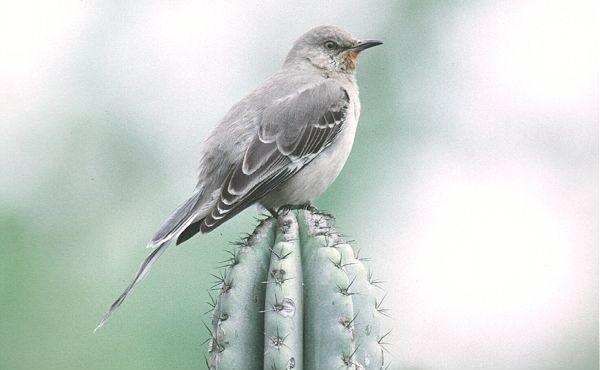Mockingbird - Northern
Mocker Scientific Name: Mimus polyglottus
Sat, 12th July, 2025 - 8:41 am GMT
Sponsor Ads:

Alternative Name
Mocker Scientific Name: Mimus polyglottusBasic Info
At maturity, the Mockingbird measures about nine to ten inches (25 centimeters) in length. Most of the plumage of the mockingbird is light gray, and the underside has whitish feathering. Its wings and long tail are darker gray, and may have white splotches on them. Mockingbirds are so adept at imitating noises that, in some electric analyses when comparing the Mockingbird's voice and the original sound, no difference was seen!
Health
Northern Mockingbirds can be attracted to your yard by using a suet feeder and a fruit feeder. Pomegranates and apples may be special favorites. Berries, figs, and grapes are also all appreciated. Mockingbirds also love to bathe, so you should have a water source available for them to wash in. Breeding Northern Mockingbirds begin courtship by singing! Males may become quite restless and sing constantly. The nesting season occurs between March and August, and during this time, Mockingbirds may become especially aggressive when defending their territory. Usually, the nest is built in a cup shape from twigs or other dry vegetation. Usually, between three and six blue, brown - speckled eggs are laid. The female Mockingbird will incubate these eggs for about 11 to 14 days. Once they have hatched, the male will also help care for the little birds. By the time they are about 11 days old, young Mockingbirds begin to leave the nest.Habitat
They like open, grassy areas near shrubs or thickets in which they can take cover if they feel alarmed.Behavior
The Mockingbird is aptly named because it is so adept at imitating sounds! These birds have a wide range of songs, and can imitate many other noises, such as the barking of a dog, a piano, or an emergency siren! Northern Mockingbirds, also called "Mockers", are quite territorial, and may swoop down threateningly on animals including cats, dogs, or other birds that enter the range they are defending! Although they may generally be too small to do much harm to these animals, they certainly appear more threatening than they actually are! Normally, an individual Northern Mockingbird has between 25 and 30 separate songs that it will sing on a fairly regular basis. Many people value these birds for the sweetness of their songs. The songs are actually "mockeries", and are composed of a melange of other birds' songs in addition to their own! Northern Mockingbirds are useful to have in your garden, and not only for the value of their voices.Origin
North AmericaHistory
The Mockingbird is the state bird of Texas, United States, although they range all over North and Central America. They even reside in the Hawaiian Islands, where the species was introduced. Extremely common in the Southern United States, this species was also included in the title of a classic novel set in that region, "To Kill A Mockingbird". This species is a permanent resident and is not known to migrate.Common Foods
They feed on insects, and eat some that may be considered garden pests. Mockingbirds also feed on fruits, especially in winter months, when insects may be scarce.Sponsor Ads:
always let your adversary be the one to get upset
Mockingbird - Northern
Coded by: BGID® | ALL RIGHTS RESERVED Copyright © 2000-2025
Disclaimer | Privacy | Report Errors / Contact | Credits








 President of the United States of America - Real Estate mogul, Pageant owner and now one of the most controversial men in political history.
President of the United States of America - Real Estate mogul, Pageant owner and now one of the most controversial men in political history.  Global warming has been in and out as the "latest" hot topic for many years. It is, according to modern scientists, the result of man-made industrial pollutants, clearing forested areas, agriculture, etc. But now they are thinking it started way before the Industrial Revolution...
Global warming has been in and out as the "latest" hot topic for many years. It is, according to modern scientists, the result of man-made industrial pollutants, clearing forested areas, agriculture, etc. But now they are thinking it started way before the Industrial Revolution...  Politician, US Vice President and President of the USA - Joseph Robinette Biden Jr.
Politician, US Vice President and President of the USA - Joseph Robinette Biden Jr.  versus
versus  Russia: 'The Evil Empire'? Are they all that bad or is it just the USA trying to portray Russia as bad because they are a world power with land bigger and a society very different from the USA ideal?
Russia: 'The Evil Empire'? Are they all that bad or is it just the USA trying to portray Russia as bad because they are a world power with land bigger and a society very different from the USA ideal? 
 Corona virus
Corona virus 
 Users with wide screen monitors can benefit from more content on every page.
Users with wide screen monitors can benefit from more content on every page.